GEOLOGY 101: Impacts of Climate Change and Geological History Analysis
VerifiedAdded on 2022/08/09
|9
|2626
|85
Report
AI Summary
This report for GEOLOGY 101 analyzes Earth's geological history, applying the principle of uniformitarianism to understand potential future climate scenarios. It examines the impact of rising CO2 levels, comparing them to past geological periods like the mid-Pliocene and Permian extinction events, and projects potential temperature increases and sea level rise. The report investigates the consequences of climate change, particularly focusing on the United States, assessing land loss in coastal regions like Florida, New York, and other vulnerable areas. It references scientific studies and data to illustrate the severity of the situation, emphasizing the potential for extreme climate conditions, and the need for mitigation strategies to avoid catastrophic outcomes. The report also explores the potential for a sixth mass extinction event, linking current environmental changes to past events. The study highlights the importance of understanding past climate events to anticipate and prepare for the challenges posed by climate change, emphasizing the need for immediate action to reduce greenhouse gas emissions and protect coastal populations and ecosystems.
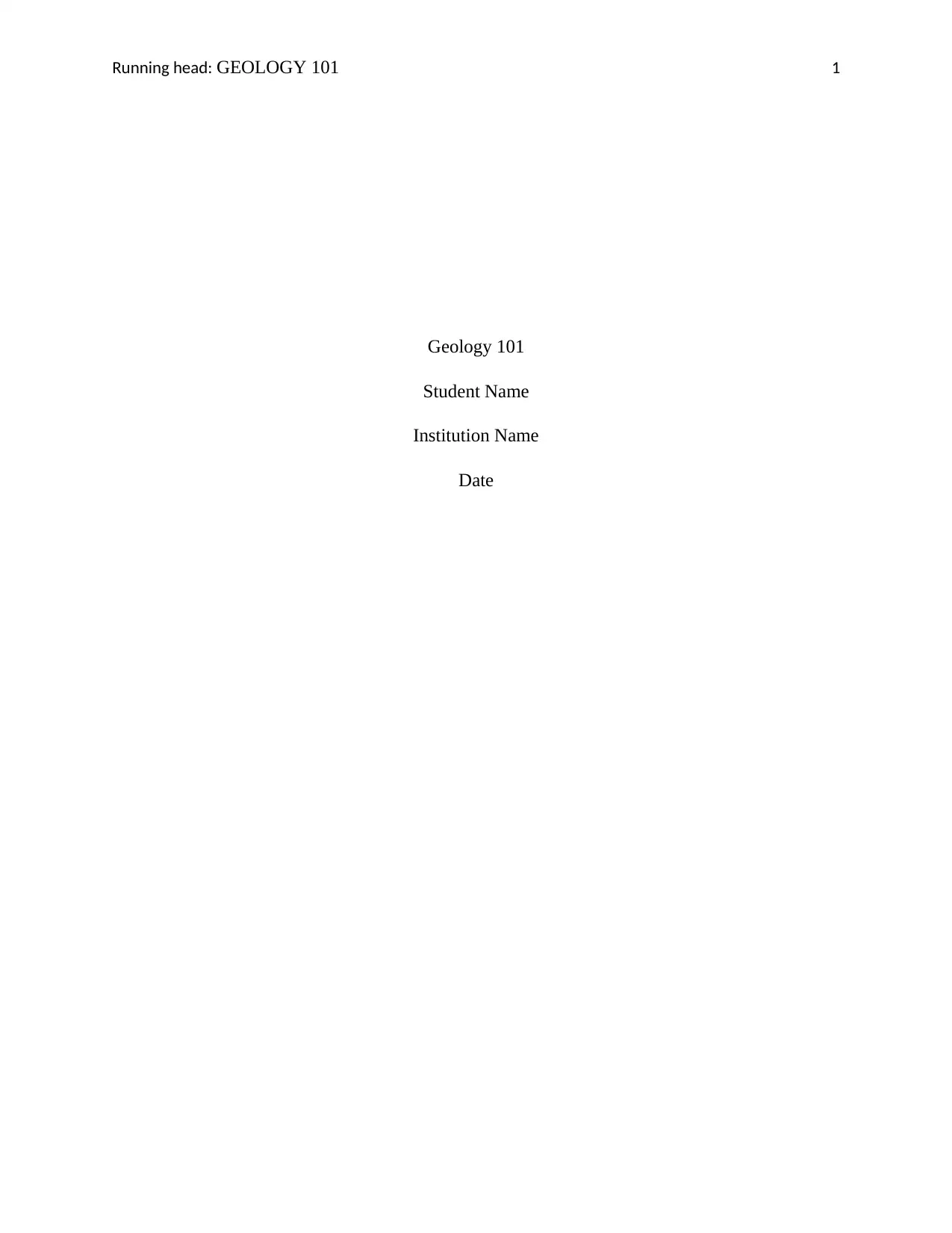
Running head: GEOLOGY 101 1
Geology 101
Student Name
Institution Name
Date
Geology 101
Student Name
Institution Name
Date
Paraphrase This Document
Need a fresh take? Get an instant paraphrase of this document with our AI Paraphraser
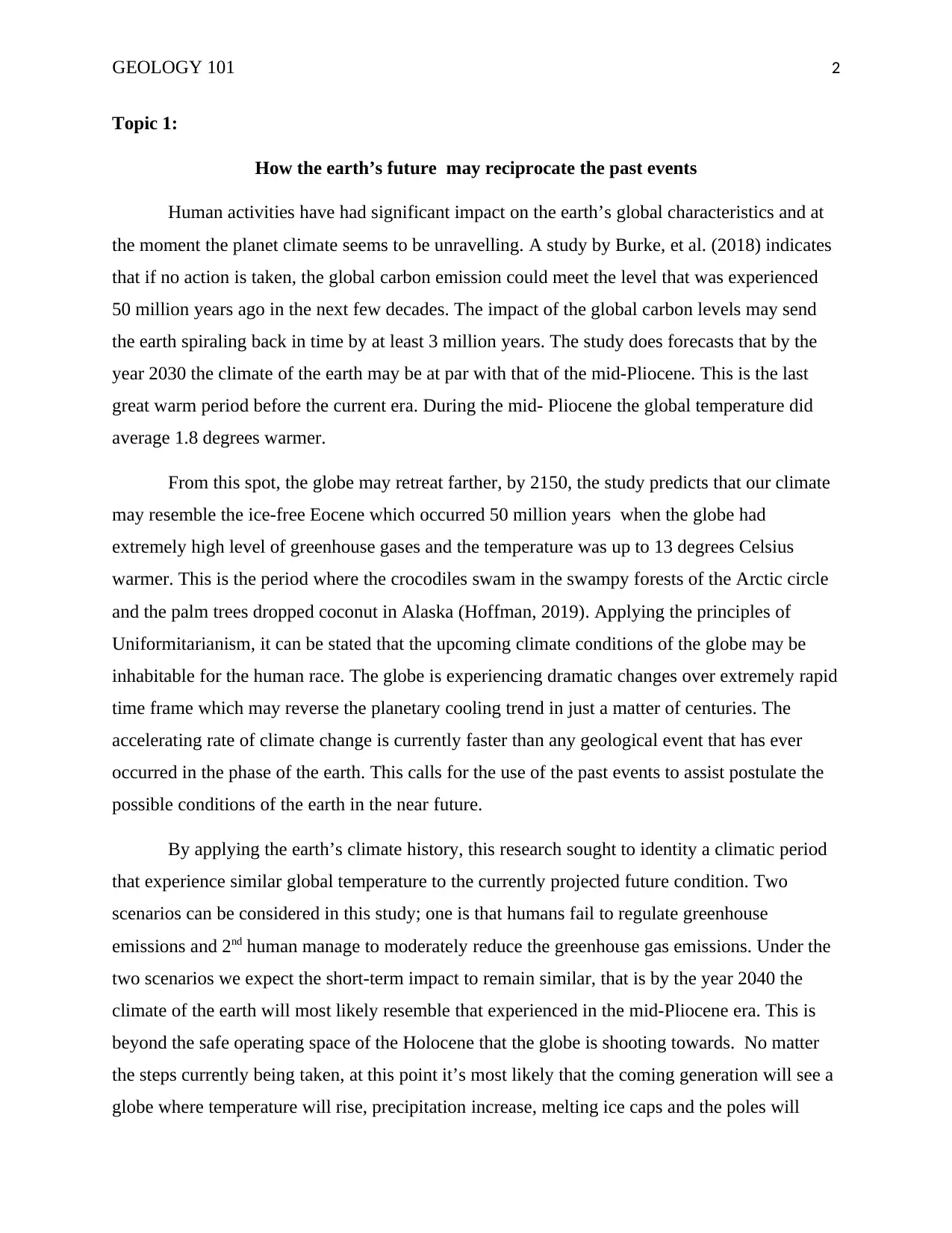
GEOLOGY 101 2
Topic 1:
How the earth’s future may reciprocate the past events
Human activities have had significant impact on the earth’s global characteristics and at
the moment the planet climate seems to be unravelling. A study by Burke, et al. (2018) indicates
that if no action is taken, the global carbon emission could meet the level that was experienced
50 million years ago in the next few decades. The impact of the global carbon levels may send
the earth spiraling back in time by at least 3 million years. The study does forecasts that by the
year 2030 the climate of the earth may be at par with that of the mid-Pliocene. This is the last
great warm period before the current era. During the mid- Pliocene the global temperature did
average 1.8 degrees warmer.
From this spot, the globe may retreat farther, by 2150, the study predicts that our climate
may resemble the ice-free Eocene which occurred 50 million years when the globe had
extremely high level of greenhouse gases and the temperature was up to 13 degrees Celsius
warmer. This is the period where the crocodiles swam in the swampy forests of the Arctic circle
and the palm trees dropped coconut in Alaska (Hoffman, 2019). Applying the principles of
Uniformitarianism, it can be stated that the upcoming climate conditions of the globe may be
inhabitable for the human race. The globe is experiencing dramatic changes over extremely rapid
time frame which may reverse the planetary cooling trend in just a matter of centuries. The
accelerating rate of climate change is currently faster than any geological event that has ever
occurred in the phase of the earth. This calls for the use of the past events to assist postulate the
possible conditions of the earth in the near future.
By applying the earth’s climate history, this research sought to identity a climatic period
that experience similar global temperature to the currently projected future condition. Two
scenarios can be considered in this study; one is that humans fail to regulate greenhouse
emissions and 2nd human manage to moderately reduce the greenhouse gas emissions. Under the
two scenarios we expect the short-term impact to remain similar, that is by the year 2040 the
climate of the earth will most likely resemble that experienced in the mid-Pliocene era. This is
beyond the safe operating space of the Holocene that the globe is shooting towards. No matter
the steps currently being taken, at this point it’s most likely that the coming generation will see a
globe where temperature will rise, precipitation increase, melting ice caps and the poles will
Topic 1:
How the earth’s future may reciprocate the past events
Human activities have had significant impact on the earth’s global characteristics and at
the moment the planet climate seems to be unravelling. A study by Burke, et al. (2018) indicates
that if no action is taken, the global carbon emission could meet the level that was experienced
50 million years ago in the next few decades. The impact of the global carbon levels may send
the earth spiraling back in time by at least 3 million years. The study does forecasts that by the
year 2030 the climate of the earth may be at par with that of the mid-Pliocene. This is the last
great warm period before the current era. During the mid- Pliocene the global temperature did
average 1.8 degrees warmer.
From this spot, the globe may retreat farther, by 2150, the study predicts that our climate
may resemble the ice-free Eocene which occurred 50 million years when the globe had
extremely high level of greenhouse gases and the temperature was up to 13 degrees Celsius
warmer. This is the period where the crocodiles swam in the swampy forests of the Arctic circle
and the palm trees dropped coconut in Alaska (Hoffman, 2019). Applying the principles of
Uniformitarianism, it can be stated that the upcoming climate conditions of the globe may be
inhabitable for the human race. The globe is experiencing dramatic changes over extremely rapid
time frame which may reverse the planetary cooling trend in just a matter of centuries. The
accelerating rate of climate change is currently faster than any geological event that has ever
occurred in the phase of the earth. This calls for the use of the past events to assist postulate the
possible conditions of the earth in the near future.
By applying the earth’s climate history, this research sought to identity a climatic period
that experience similar global temperature to the currently projected future condition. Two
scenarios can be considered in this study; one is that humans fail to regulate greenhouse
emissions and 2nd human manage to moderately reduce the greenhouse gas emissions. Under the
two scenarios we expect the short-term impact to remain similar, that is by the year 2040 the
climate of the earth will most likely resemble that experienced in the mid-Pliocene era. This is
beyond the safe operating space of the Holocene that the globe is shooting towards. No matter
the steps currently being taken, at this point it’s most likely that the coming generation will see a
globe where temperature will rise, precipitation increase, melting ice caps and the poles will
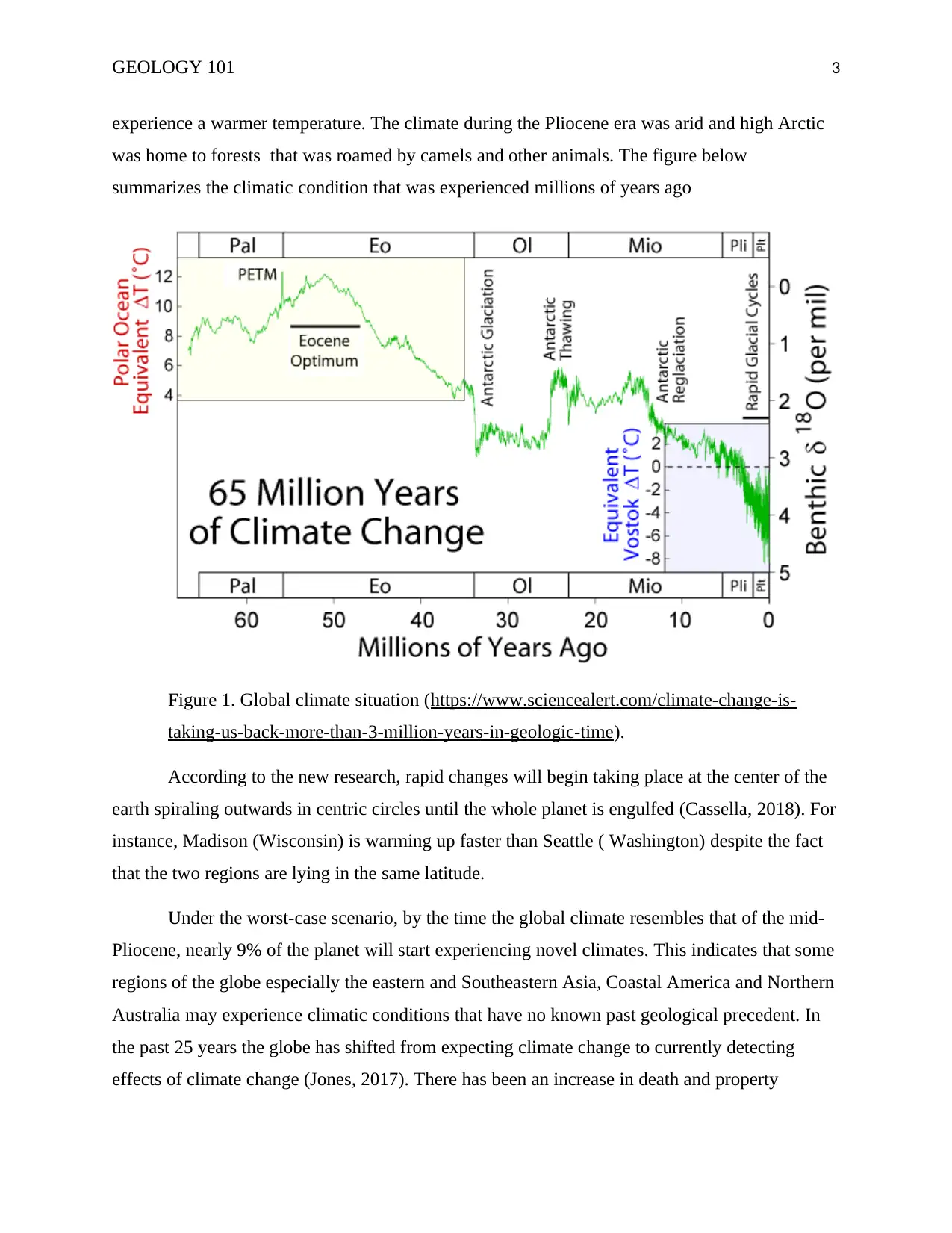
GEOLOGY 101 3
experience a warmer temperature. The climate during the Pliocene era was arid and high Arctic
was home to forests that was roamed by camels and other animals. The figure below
summarizes the climatic condition that was experienced millions of years ago
Figure 1. Global climate situation (https://www.sciencealert.com/climate-change-is-
taking-us-back-more-than-3-million-years-in-geologic-time).
According to the new research, rapid changes will begin taking place at the center of the
earth spiraling outwards in centric circles until the whole planet is engulfed (Cassella, 2018). For
instance, Madison (Wisconsin) is warming up faster than Seattle ( Washington) despite the fact
that the two regions are lying in the same latitude.
Under the worst-case scenario, by the time the global climate resembles that of the mid-
Pliocene, nearly 9% of the planet will start experiencing novel climates. This indicates that some
regions of the globe especially the eastern and Southeastern Asia, Coastal America and Northern
Australia may experience climatic conditions that have no known past geological precedent. In
the past 25 years the globe has shifted from expecting climate change to currently detecting
effects of climate change (Jones, 2017). There has been an increase in death and property
experience a warmer temperature. The climate during the Pliocene era was arid and high Arctic
was home to forests that was roamed by camels and other animals. The figure below
summarizes the climatic condition that was experienced millions of years ago
Figure 1. Global climate situation (https://www.sciencealert.com/climate-change-is-
taking-us-back-more-than-3-million-years-in-geologic-time).
According to the new research, rapid changes will begin taking place at the center of the
earth spiraling outwards in centric circles until the whole planet is engulfed (Cassella, 2018). For
instance, Madison (Wisconsin) is warming up faster than Seattle ( Washington) despite the fact
that the two regions are lying in the same latitude.
Under the worst-case scenario, by the time the global climate resembles that of the mid-
Pliocene, nearly 9% of the planet will start experiencing novel climates. This indicates that some
regions of the globe especially the eastern and Southeastern Asia, Coastal America and Northern
Australia may experience climatic conditions that have no known past geological precedent. In
the past 25 years the globe has shifted from expecting climate change to currently detecting
effects of climate change (Jones, 2017). There has been an increase in death and property
⊘ This is a preview!⊘
Do you want full access?
Subscribe today to unlock all pages.

Trusted by 1+ million students worldwide
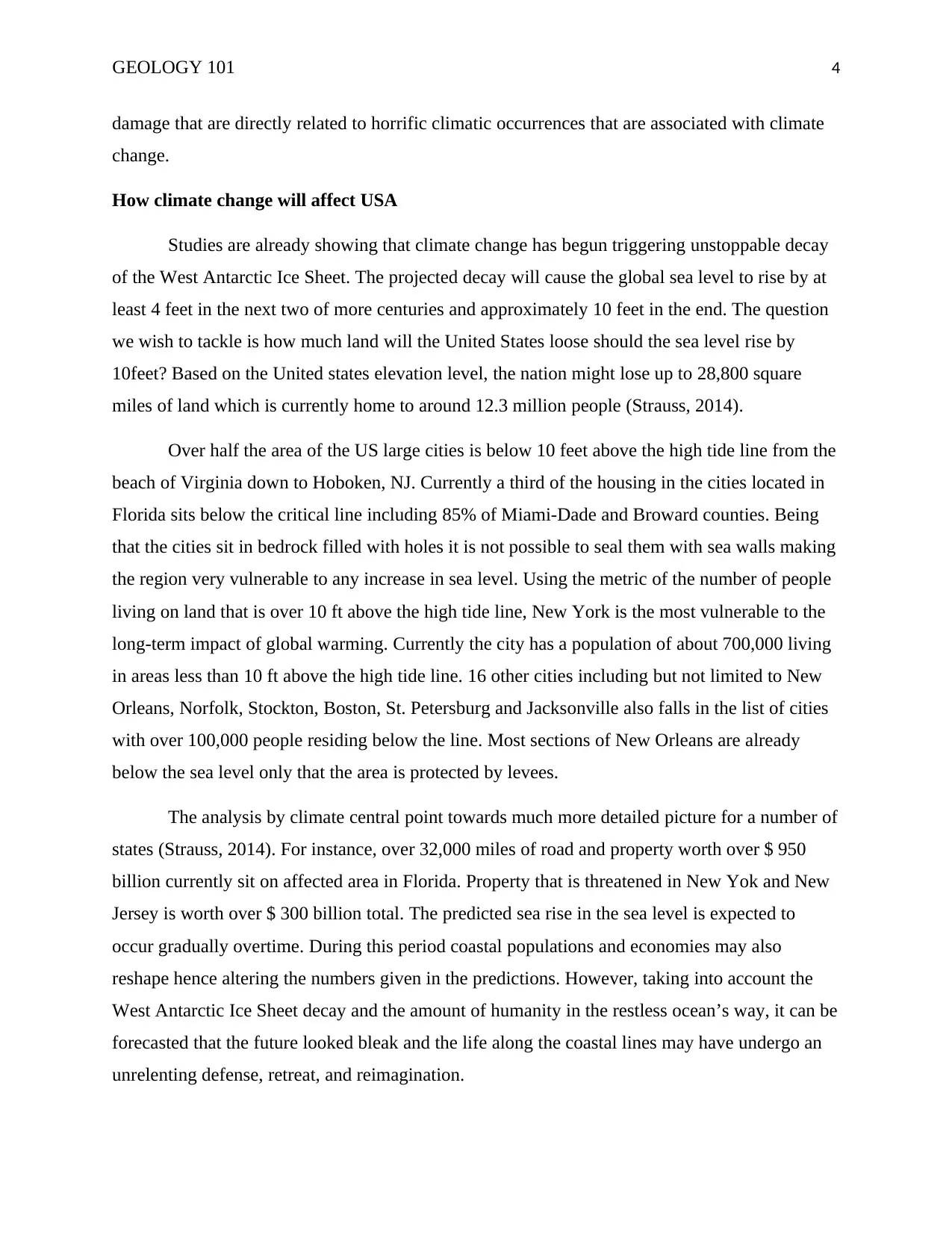
GEOLOGY 101 4
damage that are directly related to horrific climatic occurrences that are associated with climate
change.
How climate change will affect USA
Studies are already showing that climate change has begun triggering unstoppable decay
of the West Antarctic Ice Sheet. The projected decay will cause the global sea level to rise by at
least 4 feet in the next two of more centuries and approximately 10 feet in the end. The question
we wish to tackle is how much land will the United States loose should the sea level rise by
10feet? Based on the United states elevation level, the nation might lose up to 28,800 square
miles of land which is currently home to around 12.3 million people (Strauss, 2014).
Over half the area of the US large cities is below 10 feet above the high tide line from the
beach of Virginia down to Hoboken, NJ. Currently a third of the housing in the cities located in
Florida sits below the critical line including 85% of Miami-Dade and Broward counties. Being
that the cities sit in bedrock filled with holes it is not possible to seal them with sea walls making
the region very vulnerable to any increase in sea level. Using the metric of the number of people
living on land that is over 10 ft above the high tide line, New York is the most vulnerable to the
long-term impact of global warming. Currently the city has a population of about 700,000 living
in areas less than 10 ft above the high tide line. 16 other cities including but not limited to New
Orleans, Norfolk, Stockton, Boston, St. Petersburg and Jacksonville also falls in the list of cities
with over 100,000 people residing below the line. Most sections of New Orleans are already
below the sea level only that the area is protected by levees.
The analysis by climate central point towards much more detailed picture for a number of
states (Strauss, 2014). For instance, over 32,000 miles of road and property worth over $ 950
billion currently sit on affected area in Florida. Property that is threatened in New Yok and New
Jersey is worth over $ 300 billion total. The predicted sea rise in the sea level is expected to
occur gradually overtime. During this period coastal populations and economies may also
reshape hence altering the numbers given in the predictions. However, taking into account the
West Antarctic Ice Sheet decay and the amount of humanity in the restless ocean’s way, it can be
forecasted that the future looked bleak and the life along the coastal lines may have undergo an
unrelenting defense, retreat, and reimagination.
damage that are directly related to horrific climatic occurrences that are associated with climate
change.
How climate change will affect USA
Studies are already showing that climate change has begun triggering unstoppable decay
of the West Antarctic Ice Sheet. The projected decay will cause the global sea level to rise by at
least 4 feet in the next two of more centuries and approximately 10 feet in the end. The question
we wish to tackle is how much land will the United States loose should the sea level rise by
10feet? Based on the United states elevation level, the nation might lose up to 28,800 square
miles of land which is currently home to around 12.3 million people (Strauss, 2014).
Over half the area of the US large cities is below 10 feet above the high tide line from the
beach of Virginia down to Hoboken, NJ. Currently a third of the housing in the cities located in
Florida sits below the critical line including 85% of Miami-Dade and Broward counties. Being
that the cities sit in bedrock filled with holes it is not possible to seal them with sea walls making
the region very vulnerable to any increase in sea level. Using the metric of the number of people
living on land that is over 10 ft above the high tide line, New York is the most vulnerable to the
long-term impact of global warming. Currently the city has a population of about 700,000 living
in areas less than 10 ft above the high tide line. 16 other cities including but not limited to New
Orleans, Norfolk, Stockton, Boston, St. Petersburg and Jacksonville also falls in the list of cities
with over 100,000 people residing below the line. Most sections of New Orleans are already
below the sea level only that the area is protected by levees.
The analysis by climate central point towards much more detailed picture for a number of
states (Strauss, 2014). For instance, over 32,000 miles of road and property worth over $ 950
billion currently sit on affected area in Florida. Property that is threatened in New Yok and New
Jersey is worth over $ 300 billion total. The predicted sea rise in the sea level is expected to
occur gradually overtime. During this period coastal populations and economies may also
reshape hence altering the numbers given in the predictions. However, taking into account the
West Antarctic Ice Sheet decay and the amount of humanity in the restless ocean’s way, it can be
forecasted that the future looked bleak and the life along the coastal lines may have undergo an
unrelenting defense, retreat, and reimagination.
Paraphrase This Document
Need a fresh take? Get an instant paraphrase of this document with our AI Paraphraser
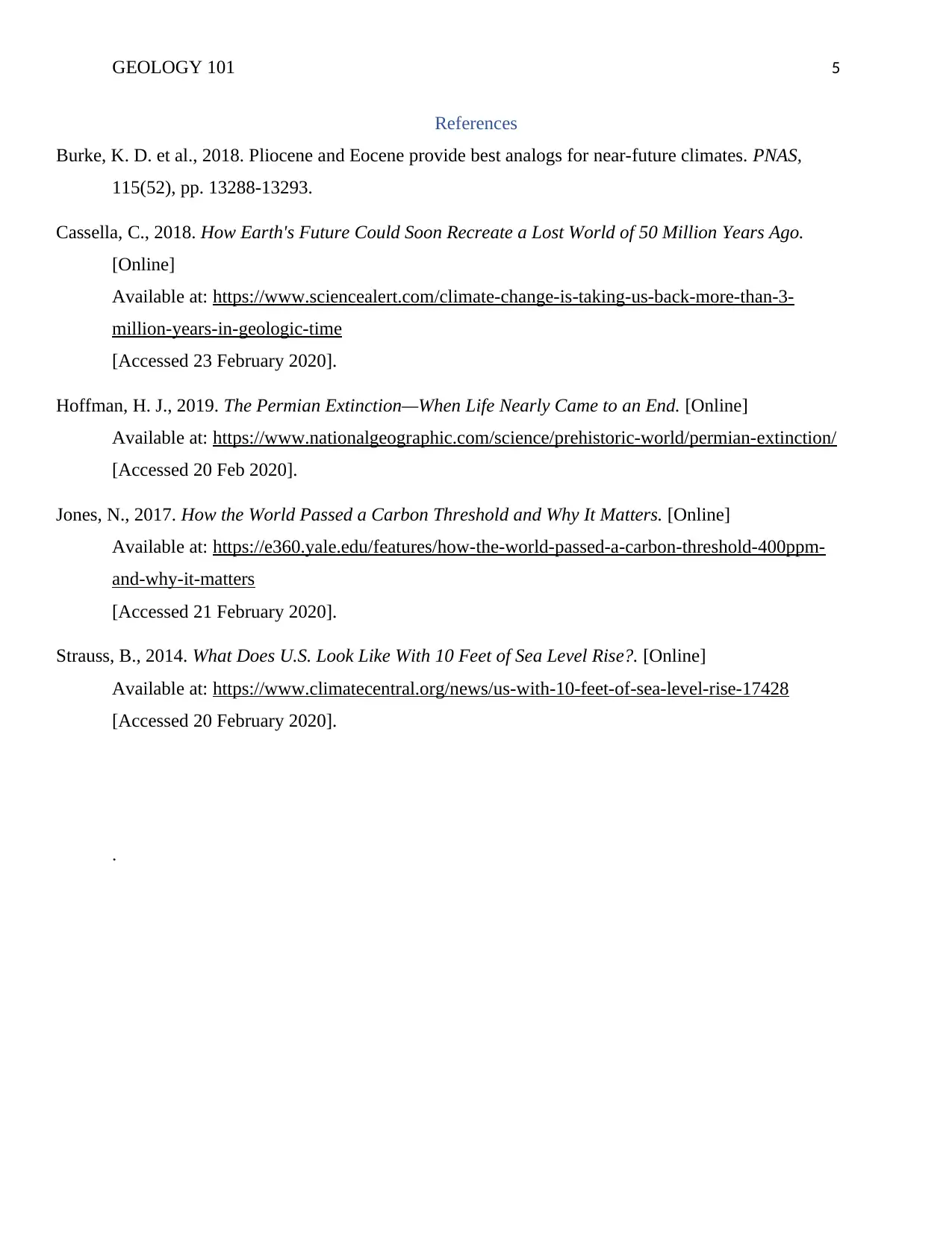
GEOLOGY 101 5
References
Burke, K. D. et al., 2018. Pliocene and Eocene provide best analogs for near-future climates. PNAS,
115(52), pp. 13288-13293.
Cassella, C., 2018. How Earth's Future Could Soon Recreate a Lost World of 50 Million Years Ago.
[Online]
Available at: https://www.sciencealert.com/climate-change-is-taking-us-back-more-than-3-
million-years-in-geologic-time
[Accessed 23 February 2020].
Hoffman, H. J., 2019. The Permian Extinction—When Life Nearly Came to an End. [Online]
Available at: https://www.nationalgeographic.com/science/prehistoric-world/permian-extinction/
[Accessed 20 Feb 2020].
Jones, N., 2017. How the World Passed a Carbon Threshold and Why It Matters. [Online]
Available at: https://e360.yale.edu/features/how-the-world-passed-a-carbon-threshold-400ppm-
and-why-it-matters
[Accessed 21 February 2020].
Strauss, B., 2014. What Does U.S. Look Like With 10 Feet of Sea Level Rise?. [Online]
Available at: https://www.climatecentral.org/news/us-with-10-feet-of-sea-level-rise-17428
[Accessed 20 February 2020].
.
References
Burke, K. D. et al., 2018. Pliocene and Eocene provide best analogs for near-future climates. PNAS,
115(52), pp. 13288-13293.
Cassella, C., 2018. How Earth's Future Could Soon Recreate a Lost World of 50 Million Years Ago.
[Online]
Available at: https://www.sciencealert.com/climate-change-is-taking-us-back-more-than-3-
million-years-in-geologic-time
[Accessed 23 February 2020].
Hoffman, H. J., 2019. The Permian Extinction—When Life Nearly Came to an End. [Online]
Available at: https://www.nationalgeographic.com/science/prehistoric-world/permian-extinction/
[Accessed 20 Feb 2020].
Jones, N., 2017. How the World Passed a Carbon Threshold and Why It Matters. [Online]
Available at: https://e360.yale.edu/features/how-the-world-passed-a-carbon-threshold-400ppm-
and-why-it-matters
[Accessed 21 February 2020].
Strauss, B., 2014. What Does U.S. Look Like With 10 Feet of Sea Level Rise?. [Online]
Available at: https://www.climatecentral.org/news/us-with-10-feet-of-sea-level-rise-17428
[Accessed 20 February 2020].
.
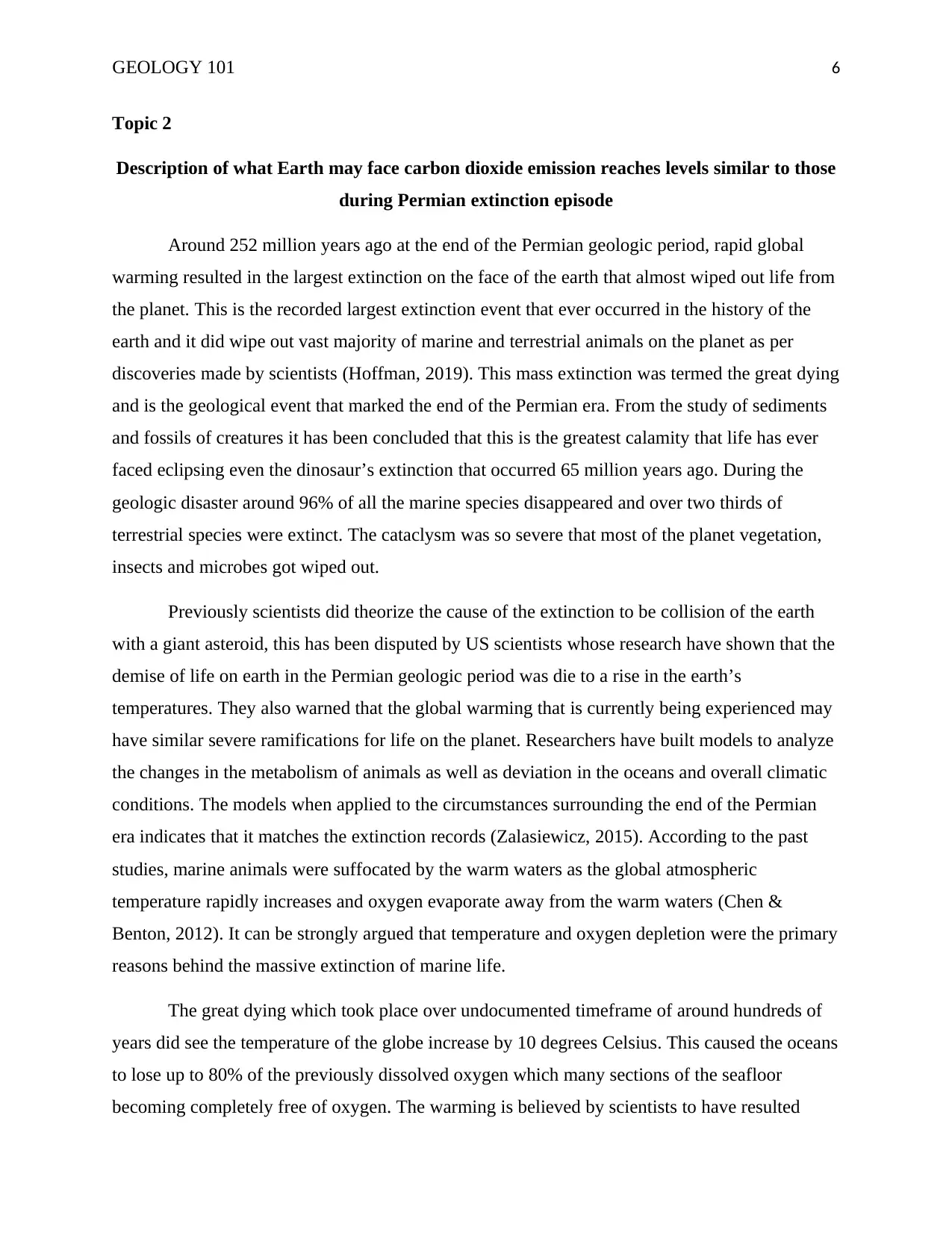
GEOLOGY 101 6
Topic 2
Description of what Earth may face carbon dioxide emission reaches levels similar to those
during Permian extinction episode
Around 252 million years ago at the end of the Permian geologic period, rapid global
warming resulted in the largest extinction on the face of the earth that almost wiped out life from
the planet. This is the recorded largest extinction event that ever occurred in the history of the
earth and it did wipe out vast majority of marine and terrestrial animals on the planet as per
discoveries made by scientists (Hoffman, 2019). This mass extinction was termed the great dying
and is the geological event that marked the end of the Permian era. From the study of sediments
and fossils of creatures it has been concluded that this is the greatest calamity that life has ever
faced eclipsing even the dinosaur’s extinction that occurred 65 million years ago. During the
geologic disaster around 96% of all the marine species disappeared and over two thirds of
terrestrial species were extinct. The cataclysm was so severe that most of the planet vegetation,
insects and microbes got wiped out.
Previously scientists did theorize the cause of the extinction to be collision of the earth
with a giant asteroid, this has been disputed by US scientists whose research have shown that the
demise of life on earth in the Permian geologic period was die to a rise in the earth’s
temperatures. They also warned that the global warming that is currently being experienced may
have similar severe ramifications for life on the planet. Researchers have built models to analyze
the changes in the metabolism of animals as well as deviation in the oceans and overall climatic
conditions. The models when applied to the circumstances surrounding the end of the Permian
era indicates that it matches the extinction records (Zalasiewicz, 2015). According to the past
studies, marine animals were suffocated by the warm waters as the global atmospheric
temperature rapidly increases and oxygen evaporate away from the warm waters (Chen &
Benton, 2012). It can be strongly argued that temperature and oxygen depletion were the primary
reasons behind the massive extinction of marine life.
The great dying which took place over undocumented timeframe of around hundreds of
years did see the temperature of the globe increase by 10 degrees Celsius. This caused the oceans
to lose up to 80% of the previously dissolved oxygen which many sections of the seafloor
becoming completely free of oxygen. The warming is believed by scientists to have resulted
Topic 2
Description of what Earth may face carbon dioxide emission reaches levels similar to those
during Permian extinction episode
Around 252 million years ago at the end of the Permian geologic period, rapid global
warming resulted in the largest extinction on the face of the earth that almost wiped out life from
the planet. This is the recorded largest extinction event that ever occurred in the history of the
earth and it did wipe out vast majority of marine and terrestrial animals on the planet as per
discoveries made by scientists (Hoffman, 2019). This mass extinction was termed the great dying
and is the geological event that marked the end of the Permian era. From the study of sediments
and fossils of creatures it has been concluded that this is the greatest calamity that life has ever
faced eclipsing even the dinosaur’s extinction that occurred 65 million years ago. During the
geologic disaster around 96% of all the marine species disappeared and over two thirds of
terrestrial species were extinct. The cataclysm was so severe that most of the planet vegetation,
insects and microbes got wiped out.
Previously scientists did theorize the cause of the extinction to be collision of the earth
with a giant asteroid, this has been disputed by US scientists whose research have shown that the
demise of life on earth in the Permian geologic period was die to a rise in the earth’s
temperatures. They also warned that the global warming that is currently being experienced may
have similar severe ramifications for life on the planet. Researchers have built models to analyze
the changes in the metabolism of animals as well as deviation in the oceans and overall climatic
conditions. The models when applied to the circumstances surrounding the end of the Permian
era indicates that it matches the extinction records (Zalasiewicz, 2015). According to the past
studies, marine animals were suffocated by the warm waters as the global atmospheric
temperature rapidly increases and oxygen evaporate away from the warm waters (Chen &
Benton, 2012). It can be strongly argued that temperature and oxygen depletion were the primary
reasons behind the massive extinction of marine life.
The great dying which took place over undocumented timeframe of around hundreds of
years did see the temperature of the globe increase by 10 degrees Celsius. This caused the oceans
to lose up to 80% of the previously dissolved oxygen which many sections of the seafloor
becoming completely free of oxygen. The warming is believed by scientists to have resulted
⊘ This is a preview!⊘
Do you want full access?
Subscribe today to unlock all pages.

Trusted by 1+ million students worldwide
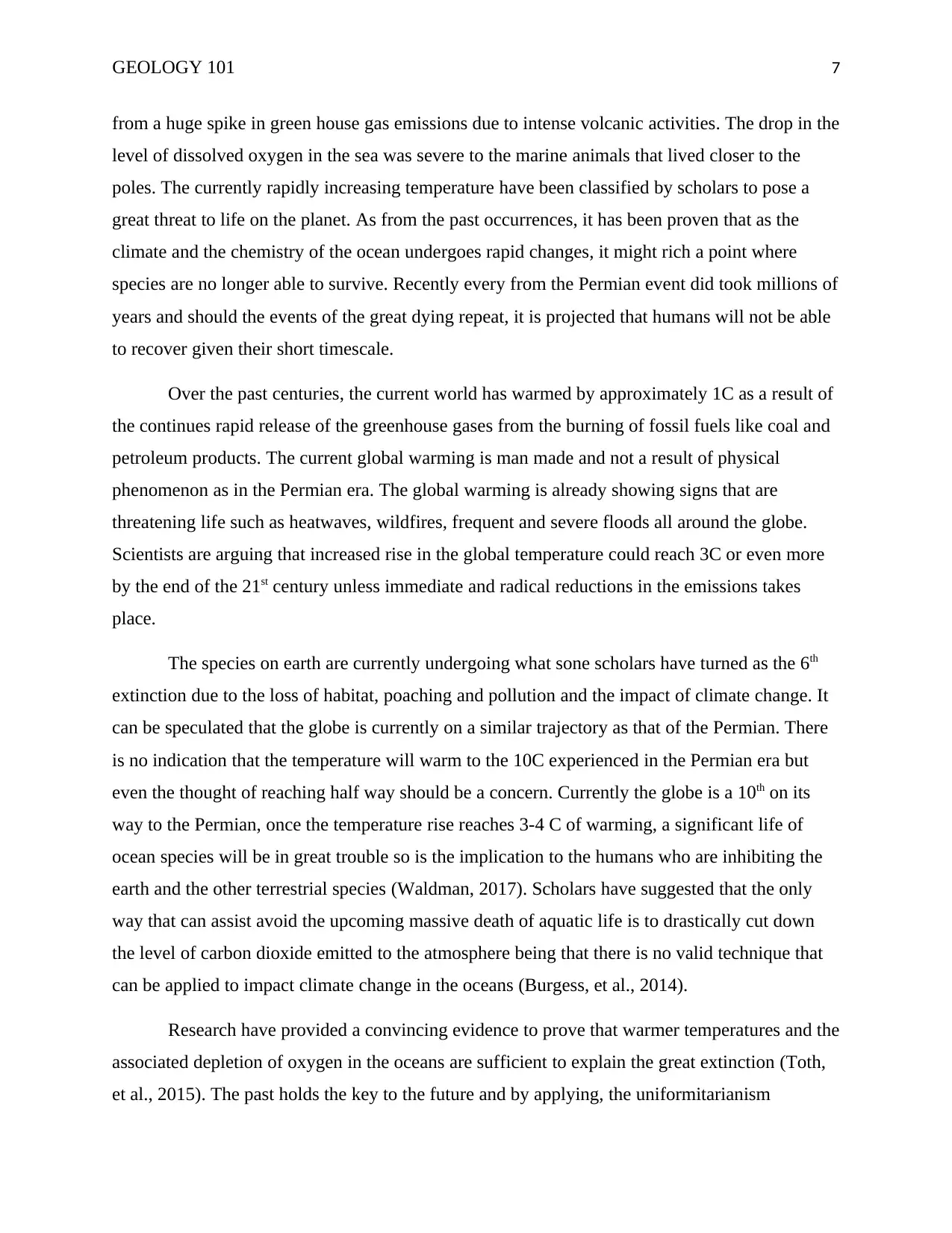
GEOLOGY 101 7
from a huge spike in green house gas emissions due to intense volcanic activities. The drop in the
level of dissolved oxygen in the sea was severe to the marine animals that lived closer to the
poles. The currently rapidly increasing temperature have been classified by scholars to pose a
great threat to life on the planet. As from the past occurrences, it has been proven that as the
climate and the chemistry of the ocean undergoes rapid changes, it might rich a point where
species are no longer able to survive. Recently every from the Permian event did took millions of
years and should the events of the great dying repeat, it is projected that humans will not be able
to recover given their short timescale.
Over the past centuries, the current world has warmed by approximately 1C as a result of
the continues rapid release of the greenhouse gases from the burning of fossil fuels like coal and
petroleum products. The current global warming is man made and not a result of physical
phenomenon as in the Permian era. The global warming is already showing signs that are
threatening life such as heatwaves, wildfires, frequent and severe floods all around the globe.
Scientists are arguing that increased rise in the global temperature could reach 3C or even more
by the end of the 21st century unless immediate and radical reductions in the emissions takes
place.
The species on earth are currently undergoing what sone scholars have turned as the 6th
extinction due to the loss of habitat, poaching and pollution and the impact of climate change. It
can be speculated that the globe is currently on a similar trajectory as that of the Permian. There
is no indication that the temperature will warm to the 10C experienced in the Permian era but
even the thought of reaching half way should be a concern. Currently the globe is a 10th on its
way to the Permian, once the temperature rise reaches 3-4 C of warming, a significant life of
ocean species will be in great trouble so is the implication to the humans who are inhibiting the
earth and the other terrestrial species (Waldman, 2017). Scholars have suggested that the only
way that can assist avoid the upcoming massive death of aquatic life is to drastically cut down
the level of carbon dioxide emitted to the atmosphere being that there is no valid technique that
can be applied to impact climate change in the oceans (Burgess, et al., 2014).
Research have provided a convincing evidence to prove that warmer temperatures and the
associated depletion of oxygen in the oceans are sufficient to explain the great extinction (Toth,
et al., 2015). The past holds the key to the future and by applying, the uniformitarianism
from a huge spike in green house gas emissions due to intense volcanic activities. The drop in the
level of dissolved oxygen in the sea was severe to the marine animals that lived closer to the
poles. The currently rapidly increasing temperature have been classified by scholars to pose a
great threat to life on the planet. As from the past occurrences, it has been proven that as the
climate and the chemistry of the ocean undergoes rapid changes, it might rich a point where
species are no longer able to survive. Recently every from the Permian event did took millions of
years and should the events of the great dying repeat, it is projected that humans will not be able
to recover given their short timescale.
Over the past centuries, the current world has warmed by approximately 1C as a result of
the continues rapid release of the greenhouse gases from the burning of fossil fuels like coal and
petroleum products. The current global warming is man made and not a result of physical
phenomenon as in the Permian era. The global warming is already showing signs that are
threatening life such as heatwaves, wildfires, frequent and severe floods all around the globe.
Scientists are arguing that increased rise in the global temperature could reach 3C or even more
by the end of the 21st century unless immediate and radical reductions in the emissions takes
place.
The species on earth are currently undergoing what sone scholars have turned as the 6th
extinction due to the loss of habitat, poaching and pollution and the impact of climate change. It
can be speculated that the globe is currently on a similar trajectory as that of the Permian. There
is no indication that the temperature will warm to the 10C experienced in the Permian era but
even the thought of reaching half way should be a concern. Currently the globe is a 10th on its
way to the Permian, once the temperature rise reaches 3-4 C of warming, a significant life of
ocean species will be in great trouble so is the implication to the humans who are inhibiting the
earth and the other terrestrial species (Waldman, 2017). Scholars have suggested that the only
way that can assist avoid the upcoming massive death of aquatic life is to drastically cut down
the level of carbon dioxide emitted to the atmosphere being that there is no valid technique that
can be applied to impact climate change in the oceans (Burgess, et al., 2014).
Research have provided a convincing evidence to prove that warmer temperatures and the
associated depletion of oxygen in the oceans are sufficient to explain the great extinction (Toth,
et al., 2015). The past holds the key to the future and by applying, the uniformitarianism
Paraphrase This Document
Need a fresh take? Get an instant paraphrase of this document with our AI Paraphraser
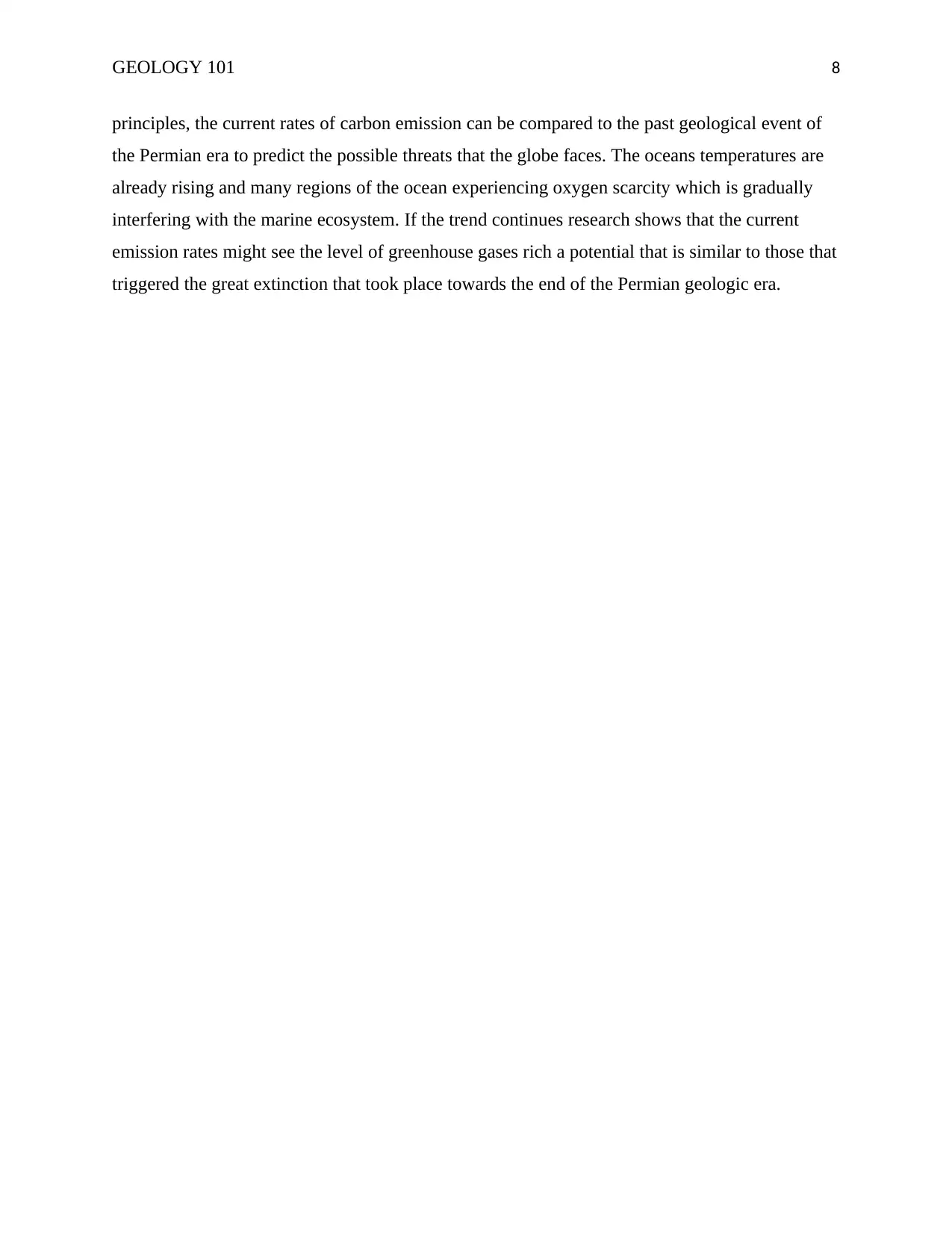
GEOLOGY 101 8
principles, the current rates of carbon emission can be compared to the past geological event of
the Permian era to predict the possible threats that the globe faces. The oceans temperatures are
already rising and many regions of the ocean experiencing oxygen scarcity which is gradually
interfering with the marine ecosystem. If the trend continues research shows that the current
emission rates might see the level of greenhouse gases rich a potential that is similar to those that
triggered the great extinction that took place towards the end of the Permian geologic era.
principles, the current rates of carbon emission can be compared to the past geological event of
the Permian era to predict the possible threats that the globe faces. The oceans temperatures are
already rising and many regions of the ocean experiencing oxygen scarcity which is gradually
interfering with the marine ecosystem. If the trend continues research shows that the current
emission rates might see the level of greenhouse gases rich a potential that is similar to those that
triggered the great extinction that took place towards the end of the Permian geologic era.
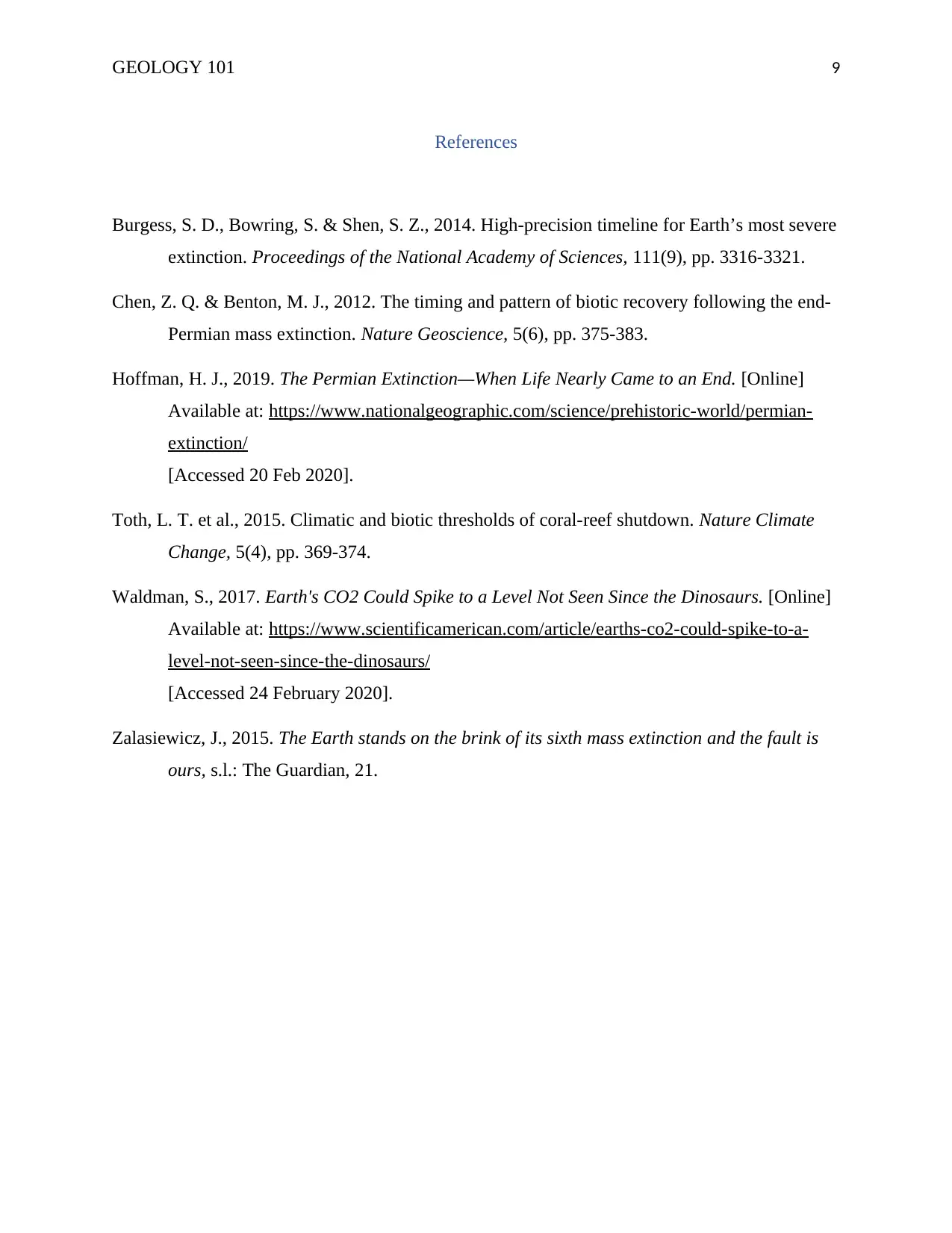
GEOLOGY 101 9
References
Burgess, S. D., Bowring, S. & Shen, S. Z., 2014. High-precision timeline for Earth’s most severe
extinction. Proceedings of the National Academy of Sciences, 111(9), pp. 3316-3321.
Chen, Z. Q. & Benton, M. J., 2012. The timing and pattern of biotic recovery following the end-
Permian mass extinction. Nature Geoscience, 5(6), pp. 375-383.
Hoffman, H. J., 2019. The Permian Extinction—When Life Nearly Came to an End. [Online]
Available at: https://www.nationalgeographic.com/science/prehistoric-world/permian-
extinction/
[Accessed 20 Feb 2020].
Toth, L. T. et al., 2015. Climatic and biotic thresholds of coral-reef shutdown. Nature Climate
Change, 5(4), pp. 369-374.
Waldman, S., 2017. Earth's CO2 Could Spike to a Level Not Seen Since the Dinosaurs. [Online]
Available at: https://www.scientificamerican.com/article/earths-co2-could-spike-to-a-
level-not-seen-since-the-dinosaurs/
[Accessed 24 February 2020].
Zalasiewicz, J., 2015. The Earth stands on the brink of its sixth mass extinction and the fault is
ours, s.l.: The Guardian, 21.
References
Burgess, S. D., Bowring, S. & Shen, S. Z., 2014. High-precision timeline for Earth’s most severe
extinction. Proceedings of the National Academy of Sciences, 111(9), pp. 3316-3321.
Chen, Z. Q. & Benton, M. J., 2012. The timing and pattern of biotic recovery following the end-
Permian mass extinction. Nature Geoscience, 5(6), pp. 375-383.
Hoffman, H. J., 2019. The Permian Extinction—When Life Nearly Came to an End. [Online]
Available at: https://www.nationalgeographic.com/science/prehistoric-world/permian-
extinction/
[Accessed 20 Feb 2020].
Toth, L. T. et al., 2015. Climatic and biotic thresholds of coral-reef shutdown. Nature Climate
Change, 5(4), pp. 369-374.
Waldman, S., 2017. Earth's CO2 Could Spike to a Level Not Seen Since the Dinosaurs. [Online]
Available at: https://www.scientificamerican.com/article/earths-co2-could-spike-to-a-
level-not-seen-since-the-dinosaurs/
[Accessed 24 February 2020].
Zalasiewicz, J., 2015. The Earth stands on the brink of its sixth mass extinction and the fault is
ours, s.l.: The Guardian, 21.
⊘ This is a preview!⊘
Do you want full access?
Subscribe today to unlock all pages.

Trusted by 1+ million students worldwide
1 out of 9
Related Documents
Your All-in-One AI-Powered Toolkit for Academic Success.
+13062052269
info@desklib.com
Available 24*7 on WhatsApp / Email
![[object Object]](/_next/static/media/star-bottom.7253800d.svg)
Unlock your academic potential
Copyright © 2020–2025 A2Z Services. All Rights Reserved. Developed and managed by ZUCOL.




